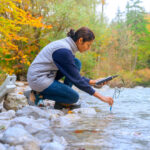Even with DNA Detection, Asian Carp Continue to Evade Scientists
When conservation manager Lindsay Chadderton came to the United States from New Zealand to help monitor the movement of invasive species between the Mississippi River and the Great Lakes, everyone was buzzing about one particular intruder: Asian carp.
The moniker includes four fish imported from China starting in the 1960s — grass carp, black carp, silver carp, and bighead carp. Together, they might be the posterchild for invasive species in the U.S. Bighead and silver dominate large stretches of the Mississippi River, outcompeting many native fish. They breed quickly, eat voraciously, grow much larger than most native fish, and, when startled, silver carp catapult out of the water. They are not just an ecological nightmare; they also pose a danger to recreational boaters and fishers. According to the United States Geological Survey, jumping Asian carp have seriously injured boaters, and water skiing on the Missouri River is “now considered exceedingly dangerous.” Scientists say these fish could wreak similar havoc in the Great Lakes.
Part of the problem with Asian carp is the difficulty catching them. When the fish number in the thousands and are actually jumping into boats, it’s easy enough. But things change on the very edge of their territory, where the fish are sparser. At low abundances, they evade nets, as well as the electrical currents biologists sometimes use to temporarily stun and catch the creatures.
Chadderton, who works at the nonprofit Nature Conservancy, and his colleagues, along with the Army Corps of Engineers and other government agencies, all wanted to know how far along the fish had actually traveled — what was the edge of their territory? Chadderton wondered: What if instead of catching the carp, biologists could find some other marker of their presence — something like environmental DNA, or eDNA? All organisms shed genetic material into the environment. In the case of fish, this happens via flaking scales, mucus, and feces. Scientists could start by sampling the water and then analyzing it for the presence of the fishes’ genetic material.
Chadderton consulted his colleagues on the project, biologists Andrew Mahon, Chris Jerde, and David Lodge. At the time, “there was literally one paper” that had used eDNA techniques to study small ponds in France, says Jerde. The Illinois River and the Chicago Area Waterway System are exponentially larger systems, he explains, so the group didn’t know what to expect. Would their samples be too dilute to capture any carp DNA?
The team took samples throughout, and following everyone’s initial surprise that the method worked, they found Asian carp DNA much closer to Lake Michigan than anyone had anticipated. Soon Michigan filed a lawsuit against the State of Illinois, demanding the closure of two shipping locks near Chicago, a move that could have decimated the city’s shipping industry. (Neighboring states joined Michigan in its fight, but in the end, the waterways remained open and so far, Asian carp haven’t established populations in the Great Lakes.)
The case never made it to court, but scientists still found themselves caught in the middle of a political battle with huge economic consequences. The furor cast doubt on the reliability of eDNA, and to this day, some government agencies are wary of employing it. Nevertheless, biologists have continued to refine their methods along the Illinois waterways. At this point, Jerde estimates, researchers have collected 30,000 water samples from this area, making it the most studied eDNA system in the world. But there is not yet a consensus on how and when to use this technique in a way that protects the environment while minimizing costs.
“One of the rubs right now of the eDNA approach is it takes time to go from 100 samples collected to 100 samples processed [and] analyzed with all the quality assurances and controls,” Jerde says. And if some of those samples come back positive for the target species — what happens next?
Scientists were using environmental DNA to look for bacteria in marine sediments as early as the 1980s, but it took several decades before researchers applied the method to look for non-native species in aquatic environments. Now that new technologies have made it easier to separate traces of DNA from water samples, eDNA is being used on every continent around the world except Antarctica. Researchers have used eDNA to monitor invasive species like Chinese mitten crab and American signal crayfish in England, to track populations of numerous species in ponds, and to find rare or endangered aquatic species. More recently, the tool has expanded to identify many species within an ecological community and provide metrics like population density.
In the case of Asian carp, eDNA is useful because it requires far less equipment and fewer people to collect water samples than it does to actually catch fish. But using DNA for detection is imprecise: for Asian carp, the DNA could come from fish mucus on barges traveling out of the Illinois River and into Chicago, or from bird poop containing digested carp.
Adam Sepulveda, an aquatic ecologist with the United States Geological Survey, compares eDNA to a smoke detector. Just because the alarm is going off, doesn’t mean your house is on fire. Someone may have simply burnt the toast. Likewise, a positive DNA hit for Asian carp doesn’t mean they’ve established a breeding population in the area, just that something carried their DNA to that spot. All of this makes it incredibly difficult to know how to respond to a positive detection.
In the fall of 2019, the Illinois Department of Natural Resources, U.S. Fish and Wildlife Service, and other partners came back from water sampling trips on the Chicago waterways with a record high number of positive DNA hits for silver and bighead carp. All of the positive samples came from Bubbly Creek, just two and a half miles from Lake Michigan. Those results triggered a two-week fishing frenzy: agency biologists and contract fishers visited 331 sites in the 10 miles around Bubbly Creek, capturing more than 2,000 fish with nets and electrofishing tools. Not a single one was an Asian carp.
Sepulveda notes that positive hits can result in a flurry of activity without ever turning up a live fish, and that’s a challenging undertaking for financially-strapped departments. Most fisheries managers from state and federal agencies “have been slow and cautious to embrace the tool,” Sepulveda says. “They want to make sure all the kinks are worked out because they saw the issues with Asian carp in the early 2010s when the tool was maybe brought out too early.”
Amy McGovern, the regional aquatic invasive species coordinator for USFWS, says sampling teams on the Chicago waterways in October noticed the Racine Avenue Pump Station emptying into Bubbly Creek at the time of collection. One possible reason for the high number of positives in that area is that street runoff may have contained Asian carp DNA. The fish are more popular as a cuisine among Asian communities, and this particular pump station is near Chicago’s Chinatown.
“When we do get these positive hits, it doesn’t necessarily mean it’s a live fish. We’re still trying to get better at what those sources are in terms of that area of the Chicago waterway system,” McGovern says. She adds that the collection teams have stringent quality control protocols, and never collect water during combined sewer overflow events. This was the first time they’d encountered an active pump on this location of the river, and they’re working with the city to investigate it.
Given that the issue has been closely followed by the media for more than a decade, McGovern says, it’s understandable that the public might react with shock to the sight of so many positive hits in the Chicago River. The agencies monitoring the fish want to make sure they’re not causing undue alarm. If they find the source is not a live fish, they could modify their sampling locations. In that case, “maybe Bubbly Creek is not on the list,” says McGovern.
Jerde argues that the eDNA method is sound, but the response can sometimes be lackluster. “We’ll tell them, this is where we’re getting the positive detections, but then they go back two months later and try to catch a fish. There’s so many reasons that will fail, the main one being that fish swim.”
In this most recent case, the samples from Bubbly Creek that showed a high number of positive hits were taken at the beginning of October. But processed results didn’t come out for another three weeks. Then, cold weather prevented crews from doing fishing surveys. It wasn’t until the end of November that the final sweeps were done on the Chicago River, a month and a half after the eDNA samples were taken. Maybe the DNA came from a source other than live fish, or maybe the fish just moved on.
Seth Herbst, who works for Fisheries Division of the Michigan Department of Natural Resources, says that the eDNA response strategies should reflect the state of a given waterway. For the state of Illinois, Asian carp have already arrived and established themselves. The goal, then, is to keep populations from exploding by intensively fishing on the Illinois River and monitoring the Chicago waterways with eDNA. For the state of Michigan, more resources go towards monitoring because so far Asian carp haven’t established there.
“Using eDNA on a regular or routine basis is important,” Herbst says. “Once or twice a year may not be the best approach.” It’s also important to identify potential contamination sources, he says.
For Sepulveda, a solution to the eDNA quandary might arrive in the form of a related technology. Researchers are currently experimenting with extracting another genetic material called RNA (ribonucleic acid) from aquatic environments. While DNA comes in the iconic double helix shape, an organism’s RNA is only a single strand — and it decays much faster. DNA can last in certain environments for weeks, months, and even years; RNA falls apart in hours to days. If a technique can be developed to extract environmental RNA, it could provide much more solid proof that the sample came from a live creature — or at least, from a creature that was alive until very recently. There’s also some work being done to create chemical solutions that capture larger strands of DNA, which would again offer more confidence that the DNA came from a live fish rather than mucous or bird feces.
But as techniques are being developed and improved, Sepulveda says, “We are trying as hard as we can to vet eDNA as a method for making big, important decisions.”
“From my perspective, he added, “we made huge advances in the last 10 years in eDNA. But those are still slowly transferring over to managers.”
Lorraine Boissoneault is a Chicago-based journalist who writes about science, history, and outdoor adventure for publications like Smithsonian Magazine, The Atlantic, National Geographic, Hakai Magazine, Atlas Obscura, Great Lakes Now, and Playboy. She is the author of the narrative nonfiction book “The Last Voyageurs” (Pegasus/2016), a finalist for the Chicago Book of the Year award. You can find her work at www.lboissoneault.com or on Twitter @boissolm











